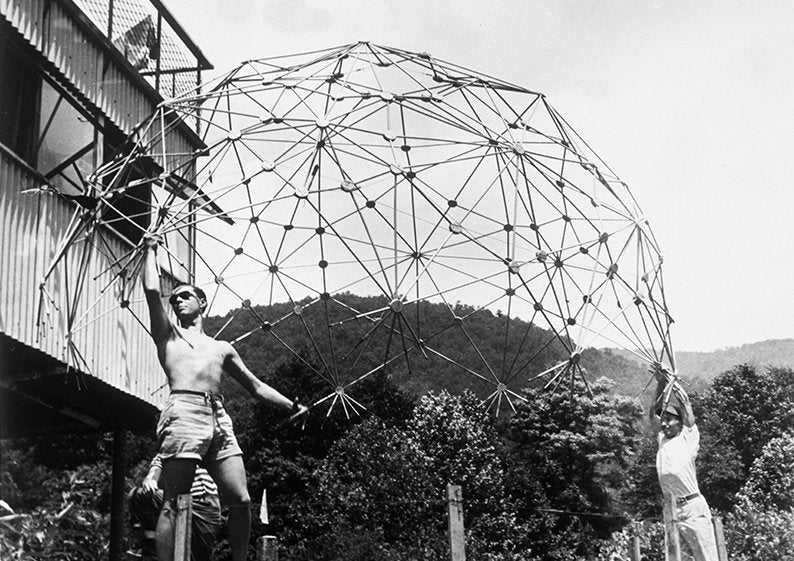
Eva Diaz is Associate Professor in History of Art and Design at the Pratt Institute. She has published widely on Buckminster Fuller and is the author of the bookThe Fuller Effect: The Critique of Total Design in Postwar Art.
Buckminster Fuller invented the geodesic dome during his time at Black Mountain College a small, experimental college that ran from 1933 to 1957.
He arrived in the summer of 1948, travelling in a three-wheeled motor home filled with energetic geometry models for his first-ever teaching appointment. While at the college, he delivered marathon lectures on topics ranging from global resource management to industrialization by way of military innovation.
Fuller's interest in a type of experimentation that embraced unexpected outcomes was on full view during that summer when he attempted to erect his first geodesic dome. One damp morning, after an extensive series of (pre-computer era) calculations, dozens of cheap, flexible, commercially available Venetian blind slats were assembled as the dome's armature. The dome unsurprisingly failed to rise, and was good-naturedly termed the Supine Dome.
According to Fuller, though he was aware that the Venetian blinds needed to be doubled-up in order to have sufficient strength and tensile capability to elevate the dome, he decided to push ahead with insufficient materials so as to demonstrate that structures could be gradually built up to the point of standing in order to create materially and economically efficient buildings. Lightness was a prime feature of the dome's design; as he stated, I want to build a building that [people are] not afraid of having collapse because it's so light it can't hurt anybody, it's like confetti So you start with this supine thing, and then keep fortifying until it's standing up.
The students were inspired by the failure and refused to give up. The following year, both the students and Fuller successfully erected a geodesic dome.
The principle that directed Fuller's dome was the idea of doing more with less. He discovered that if a spherical structure was created from triangles, it would have huge strength. The dome enacts this principle of more with less as the sphere is able to enclose a large volume of interior space with a small surface area, meaning that it requires minimal materials.
Ad hoc geodesic domes continue to be important today as a form of improvised construction using cheap or recycled materials. It is often used in humanitarian relief efforts and is a popular choicea kind of architectural wallpaper of our timefor temporary outdoor art exhibitions and cultural pavilions. The intervening years since I first published on this phenomena have seen a veritable boom in dome construction in specifically art display contexts; note the use of a geodesic dome as a hub in the 8th Mercosul Biennial in Porto Alegre, Brazil in 2011; a dome in Hyde Park, London at the Serpentine Gallery in 2011-2012; as well as the large-scale performance dome sponsored by Volkswagen in MOMA-PS1's garden and its smaller cousin the VW2 Dome in Rockaway Beach, Queens in 2013. It seems that every institution is getting in on it these days.
Buckminster Fuller was one of the world's first futurists and a true global thinker. He confronted old paradigms, shifting the way we approached world issues. Though he created and experimented with many things through his lifetime the dome remains his greatest invention.
Words by Eva Diaz. Images by Western Regional Archives, State Archives of North Carolina.
Add a comment